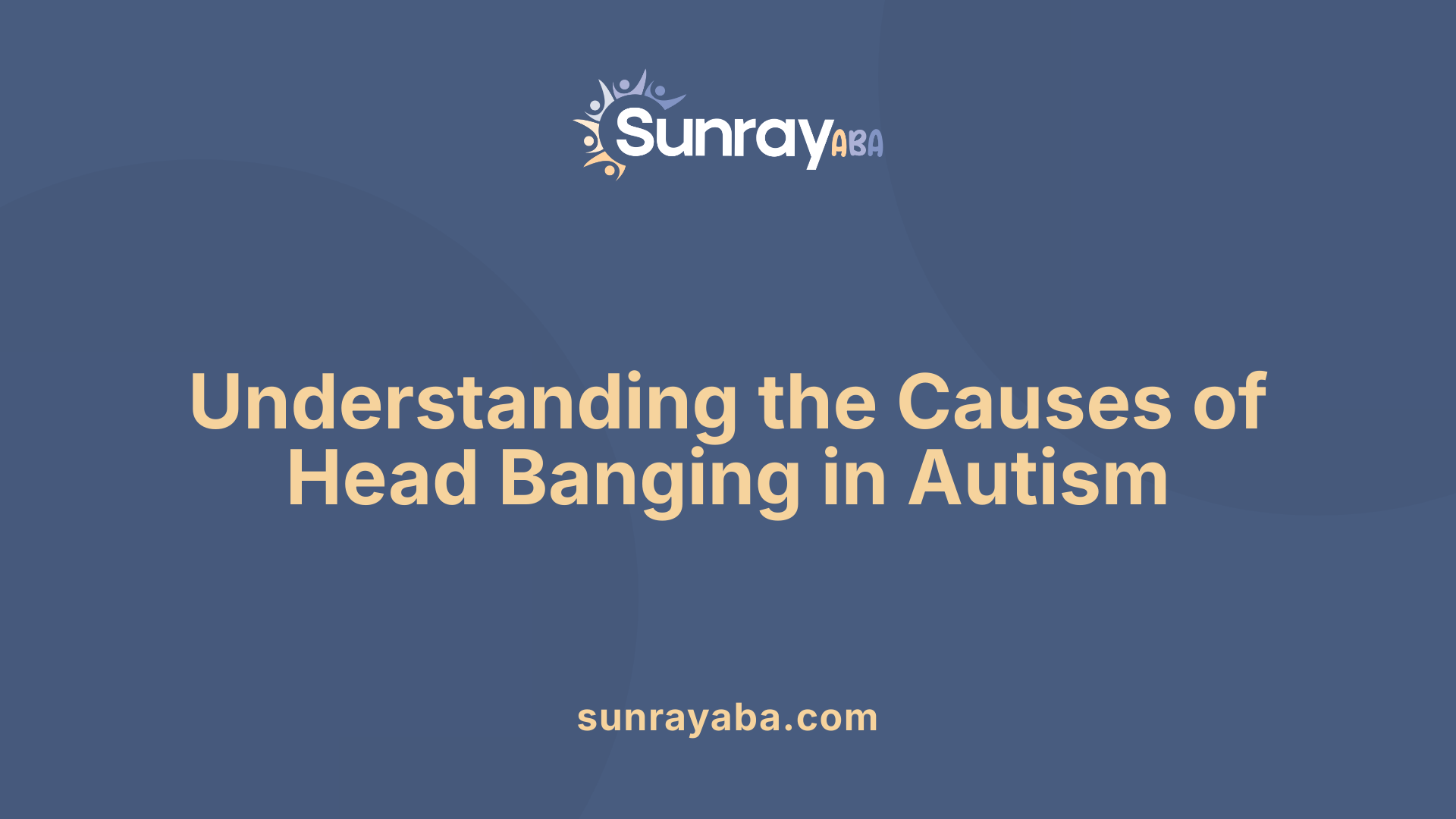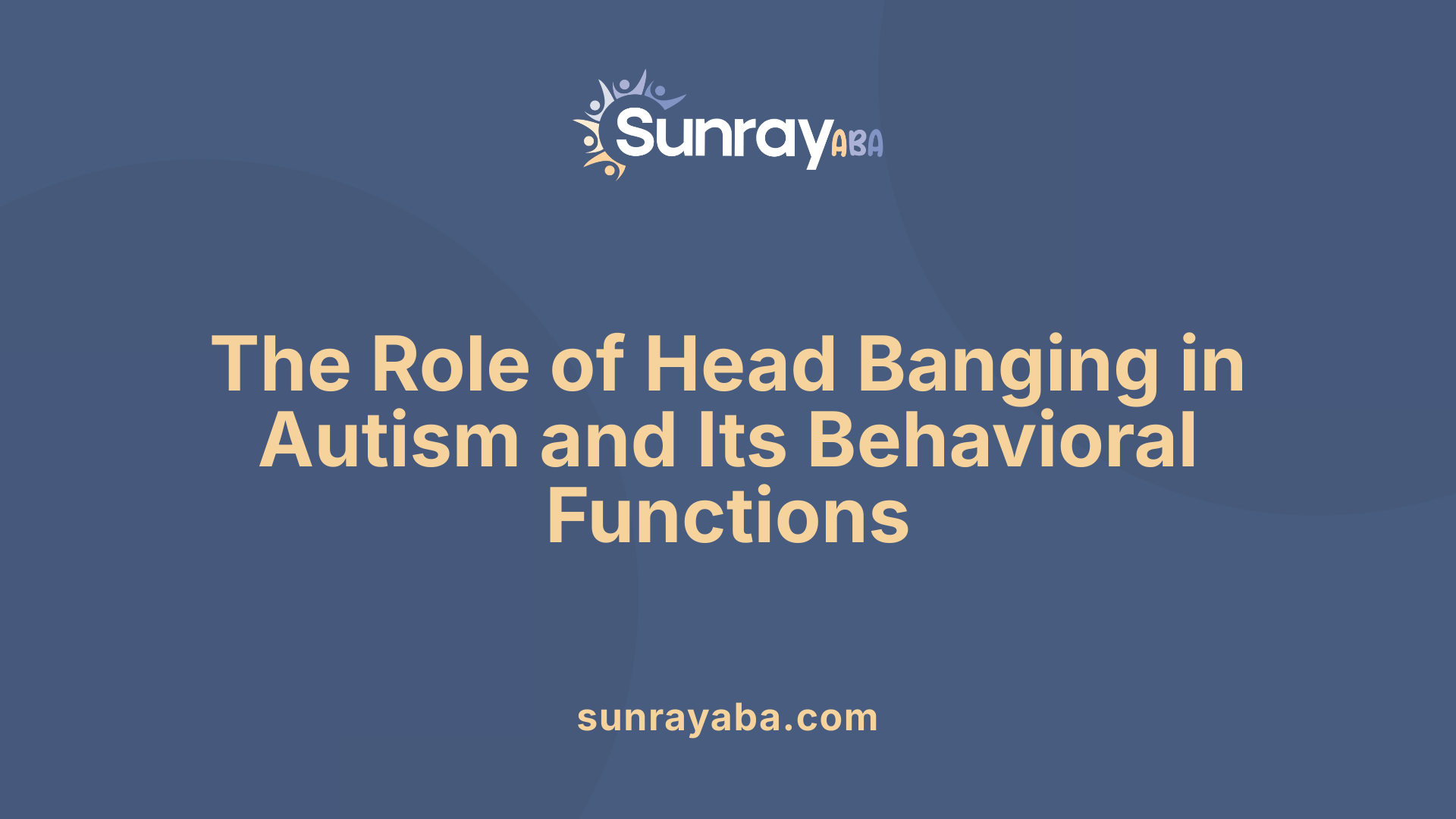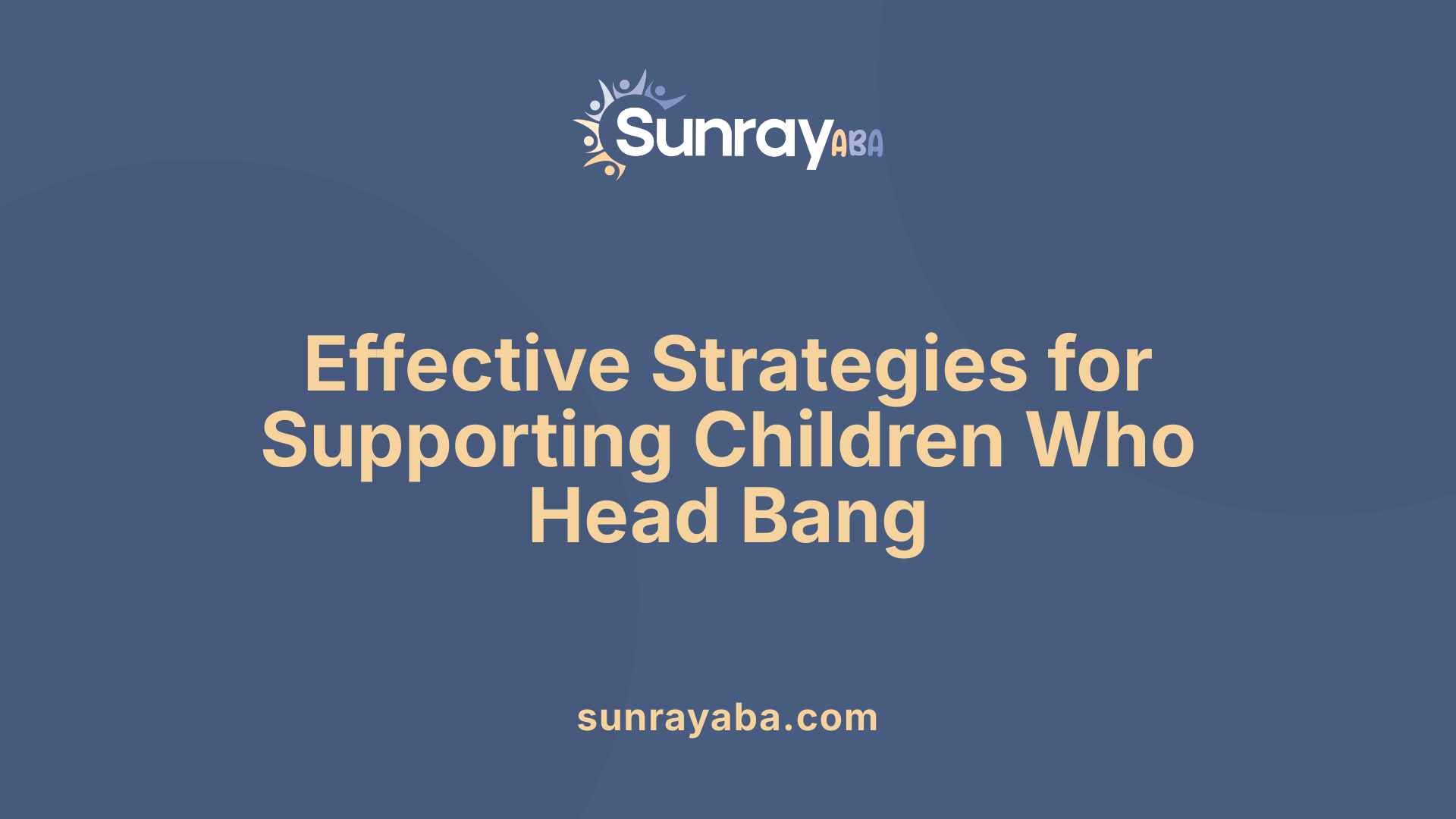Head Banging Autism

Introduction to Head Banging in Autism
Head banging is a common behavior observed in children with autism spectrum disorder (ASD), involving repeated hitting of the head against surfaces such as walls, furniture, or the floor. While often perceived as a sign of distress or frustration, it is a multi-faceted behavior with various underlying causes. This article explores the behavioral characteristics, triggers, causes, and management strategies related to head banging in children with autism, offering guidance for caregivers, professionals, and educators.
Causes and Underlying Factors of Head Banging in Autism

What causes head banging in children with autism?
Head banging in children on the autism spectrum often stems from multiple interconnected causes. Sensory processing issues are a common factor, where children may either seek additional sensory input or attempt to cope with overwhelming stimuli. For some children, head banging functions as a form of self-soothing, helping to regulate heightened emotions such as frustration, anxiety, or stress.
Communication challenges can also lead to head banging. When children struggle to express their needs verbally, they may resort to physical behaviors like head banging to attract attention or signal discomfort.
Physical discomfort or pain, such as ear infections, headaches, or teething, can naturally provoke head banging as a way to respond to their physical state.
Attention-seeking behavior is another reason behind head banging. Children sometimes learn that this action garners caregiver attention, whether positive or negative, and may use it to fulfill social needs.
Environmental changes, like routine disruptions or overstimulation from noisy or chaotic settings, can trigger head banging as a coping mechanism or stress response.
Understanding these underlying causes helps caregivers and professionals design effective interventions. These may include creating sensory alternatives, teaching communication skills, and working with behavioral specialists to develop personalized behavior plans. By addressing the specific function of each child's head-banging behavior, it is possible to reduce harm and support their emotional and sensory needs effectively.
Research indicates that identifying triggers through functional behavioral assessments (FBA) is crucial. Such assessments help pinpoint whether head banging stems from sensory needs, communication barriers, or emotional distress, thereby guiding targeted strategies for intervention.
Developmental Norms and When to Be Concerned

Typical age of onset: from 6 months to 4 years
Head banging is common in infants and young children, often emerging between 6 months and 2 years old. It is generally a self-soothing behavior or a way to explore sensory input. Most children will gradually reduce or stop head banging as they develop better communication skills and coping strategies. This behavior can sometimes peak around ages 1 to 2 but tends to decline spontaneously by age 3 or 4.
Normal self-soothing behaviors in infancy and early preschool
In early childhood, behaviors like head banging, rocking, or hand-flapping are often part of normal development. These actions can help children manage feelings of frustration, boredom, or overstimulation. Parents might notice children banging their heads lightly against surfaces or engaging in rhythmic movements during periods of stress or exhaustion.
Signs that head banging may need medical or developmental evaluation
While head banging is typically normal in young children, certain signs suggest it may indicate underlying concerns. If a child continues the behavior beyond age 3, occurs very frequently, or leads to injuries such as bruises, cuts, or even concussions, medical advice should be sought. Persistent head banging, especially if it is aggressive or intense, might also be associated with developmental delays, sensory processing issues, or neurological disorders. When head banging is accompanied by lack of eye contact, language delays, or abnormal reactions to stimuli, a thorough developmental assessment is advisable.
Long-term risks and injury potential
Prolonged or vigorous head banging can result in physical injuries, including scalp bruises, forehead swelling, or more severe trauma like skull fractures or brain injury. Although children under age 3 are less likely to sustain serious harm due to the pliability of their skulls, older children are at increased risk. Additionally, persistent self-injurious behaviors can lead to emotional and developmental impacts, emphasizing the importance of monitoring and appropriate intervention.
When to seek help
If head banging continues beyond preschool age, is frequent, causes injuries, or if there are signs of developmental delay, consulting healthcare professionals is essential. Pediatricians or developmental specialists can evaluate for underlying medical or neurodevelopmental conditions and recommend strategies to reduce harm while supporting the child's overall well-being.
Head Banging as a Symptom of Autism and Its Behavioral Functions

Does head banging stand as a symptom of autism?
Head banging is considered a common form of self-injurious behavior (SIB) among children with autism spectrum disorder (ASD), with studies estimating prevalence rates of about 20% to 50%. While it is not classified as a core symptom of autism—such as communication difficulties or social challenges—it frequently appears in early childhood, often beginning between 6 and 18 months of age. This behavior can serve various functions related to the child's needs and experiences.
Children who head bang may do so as a way to self-soothe during times of stress or anxiety. It can also be an attempt to communicate needs or discomfort when verbal skills are limited. Additionally, head banging may help regulate sensory input—either seeking stimulation in cases of under-stimulation or reducing overwhelming sensory overload.
Environmental factors such as frustration from communication challenges, physical pain from illnesses or injuries, or emotional distress can trigger head-banging episodes. Sometimes, it is used to attract attention from caregivers or as a way of expressing feelings they cannot articulate.
Although head banging can be dangerous—leading to injuries like bruises, swelling, or even skull fractures—it is more accurately viewed as a behavioral response linked to broader autism-related difficulties rather than a definitive sign or symptom of autism itself.
Effective management involves conducting functional behavioral assessments to understand what serves as a trigger or reinforcement for the behavior. Based on these insights, interventions such as teaching alternative communication strategies, providing sensory integration activities, or modifying environmental elements are implemented to reduce harm and support the child's overall well-being.
For further understanding, exploring the connection between autism and head banging can provide more detailed insights into why this behavior occurs and how best to address it.
Supporting Children Who Head Bang: Strategies for Caregivers and Professionals

How can caregivers support children with autism who engage in head banging?
Supporting children who head bang involves a comprehensive approach that addresses safety, underlying causes, and alternative behaviors. Caregivers should start by evaluating whether the behavior is linked to physical discomfort or medical issues, such as ear infections or headaches, and seek medical advice when necessary. Ensuring a safe environment is critical—this can include padding areas where head banging occurs, using protective headgear, or installing barriers to prevent injury.
Providing sensory input through safe means, like weighted hats, chewy jewelry, or tactile brushes, helps memenuhi the sensory needs that may trigger head banging. Children often use this behavior to self-soothe or communicate needs that they cannot verbalize, so teaching alternative ways to express themselves is essential.
This can involve introducing communication tools like picture exchange or speech devices, and engaging children in physical activities such as jumping or swinging to release excess energy.
Creating predictable routines reduces stress and prevents overstimulation. Managing environmental factors—avoiding sudden changes or loud noises—and establishing calming spaces with soft lighting and noise-canceling headphones can support emotional regulation.
Collaboration with healthcare professionals such as occupational therapists, behavior analysts, or pediatricians is fundamental. They can develop tailored intervention plans based on functional behavioral assessments. These plans may include teaching new communication skills, reinforcement of positive behaviors, and strategies to manage emotional or sensory overloads.
Overall, understanding and addressing the root causes, providing safety measures, and supporting communication and sensory needs form the core of effective caregiving for children who head bang.
Intervention Techniques and Therapies
 What are effective management and intervention strategies for head banging in autism?
What are effective management and intervention strategies for head banging in autism?
Managing head banging behaviors requires a comprehensive, tailored approach that focuses on the child's specific needs and underlying causes. First, it’s essential to conduct a Functional Behavioral Assessment (FBA) to identify what triggers the behavior—be it sensory, communication, or emotional factors.
Based on the FBA, therapies like Applied Behavior Analysis (ABA) can be used to teach appropriate behaviors and reinforce positive alternatives. Functional Communication Training (FCT) helps children express their needs verbally or through gestures instead of engaging in self-injury.
Sensory integration techniques are also vital. Providing sensory-rich activities, such as squeezing stress balls, using weighted blankets, or engaging with sensory toys, can help meet children’s sensory needs and reduce head banging caused by overload or under-stimulation.
Creating a safe environment is equally important. Padding surfaces, using protective headgear like helmets, and installing barriers can prevent injuries if head banging occurs.
It’s crucial to work closely with healthcare professionals, including occupational therapists, pediatricians, and behavioral specialists, to rule out physical causes like pain or medical issues. Addressing underlying conditions like anxiety or depression can significantly decrease self-injurious behaviors.
In some cases, physical modifications such as using protective equipment or modifying the environment can be necessary to ensure safety while behavioral techniques address the root causes. Developing an individualized Behavior Intervention Plan (BIP) helps coordinate these strategies effectively.
Overall, combining behavioral, sensory, and medical interventions fosters safer, more adaptive behaviors, supporting children with autism in communicating and coping better with their environment.
Physical Safety Measures and Support Equipment

Are there specific equipment like helmets used for head banging in autism?
Yes, there are specialized helmets designed to protect children with autism who engage in head banging. These helmets are available in various styles, including soft-shell, hard-shell, and full-coverage options, to suit individual safety needs.
The primary purpose of these helmets is to prevent injuries such as skull fractures, bruises, or brain trauma during episodes of head banging. Some helmets come with features like faceguards or visors, especially for children who tend to fall forward or backward.
While helmets do not stop the behavior itself, their use can significantly reduce the risk of serious injury. They are typically recommended for children whose head banging is severe or persists into older ages.
Importantly, helmet use should always be supervised and evaluated by healthcare professionals. Proper fitting is essential to ensure comfort and effectiveness. Thermoplastic helmets should be adjusted regularly as the child grows, and caregivers should be trained on how to monitor fit and safety.
In addition to helmets, padding on doorframes, furniture, or other sharp edges can provide extra safety. Creating a safe environment combined with behavioral strategies offers the best protection for children prone to head banging.
Safety considerations and supervision
Ensuring safety involves more than just equipment. Close supervision, especially during times when head banging is likely, helps prevent injuries. Using visual cues or calming strategies can reduce the frequency or intensity of episodes.
Assessing the need for protective gear
A professional assessment by pediatricians, occupational therapists, or behavioral specialists can determine if safety equipment is necessary. Factors influencing this decision include the severity of head banging, frequency, and whether the child has experienced injuries in the past.
Proper fitting and supervision
Properly fitted helmets are crucial for wearing comfort and safety. Ill-fitting helmets can cause discomfort or fail to provide adequate protection.
Caregivers should also supervise the child at all times while wearing safety equipment, and healthcare providers should regularly review and adjust the use of such gear.
| Equipment Type | Purpose | Considerations |
|---|---|---|
| Soft-shell helmets | Minimize impact injury | Suitable for mild to moderate head banging |
| Hard-shell helmets | Provide maximum protection | Used in severe cases, professional fitting needed |
| Full coverage helmets | Complete head and face safety | Usually for high-risk behaviors, professional supervision necessary |
Adaptation of safety equipment should be part of a comprehensive strategy that includes behavioral support and environmental modifications, ensuring a safer and more supportive environment for children with autism.
Conclusion and Future Directions
Managing head banging in children with autism requires a multi-dimensional approach that combines understanding the behavior's causes, implementing safety measures, and working with professionals to develop tailored interventions. Recognizing that head banging often serves functions like self-soothing, communication, or sensory regulation helps caregivers and practitioners to address it compassionately and effectively. Continued research into the biological underpinnings, such as biochemical and genetic factors, may offer new avenues for intervention. By fostering a safe, supportive environment and employing evidence-based strategies, it is possible to reduce injury risk, support emotional and sensory needs, and promote healthier coping skills, thereby improving quality of life for children with autism and their families.
References
- Understanding Autism and Head Banging: A Deep Dive
- Self-injurious behaviour - a guide for all audiences
- Autism, Head Banging and other Self Harming Behavior
- How to Handle Head Banging in Autism: A Guide for Parents
- Head banging: Why it happens and what to do about it?
- Causes and Interventions for Self-Injury in Autism
- Self-Injury in Autism Spectrum Disorder and Intellectual Disability
- Autism Head Banging: Tips and Effective Solutions
- Baby Head Banging & Autism - Sunny Days
- Understanding Autism and Head Banging: A Deep Dive